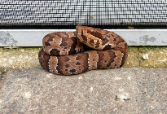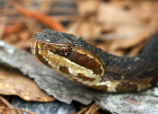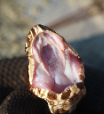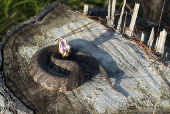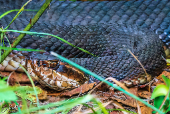Florida Cottonmouth (Agkistrodon conanti)
Description: Adults of A. conanti grow up to 74.5 inches in total length (including tail). The color pattern is very similar to that of A. piscivorus, apart from head markings that are plainly visible even in older darker specimens of A. conanti: with dark postocular stripes that are bordered above and below by narrow light lines. A pair of dark stripes are also visible at the front of the lower jaw. Mature specimens often lack any dorsal pattern, while the dorsal patterns of juveniles are more pronounced.
The Florida cottonmouth (Agkistrodon conanti) differs from the northern cottonmouth (Agkistrodon piscivorus) in having a pair of dark vertical lines at the tip of the snout (running down the seams of the rostral, prenasals, and first supralabial scales). Additionally the patterns and markings on the head of the Florida cottonmouth are typically lighter, cleaner, and more sharply defined in all except a few old individuals. Agkistrodon conanti also has a longer tail, mean relative tail length 17.4% in adult and subadult males (mean relative tail length 15.9% in adult and subadult males in Agkistrodon piscivorus).
The cottonmouths differs from all other members of the genus Agkistrodon in the absence of a loreal scale and 25 mid-body dorsal scale rows, rarely 23 or 27 (mid-body dorsal scale rows typically 23 [rarely 21 or 25] and loreal scale present in all other species). Additionally, the third supralabial usually reaches the eye orbit (small scales are usually between supralabials and the eye orbit in all other species)
Habitat: In the Okefenokee Swamp A. conanti occurs in thickets along the edges of the cypress ponds of the islands, around the wooded edges of stretches of water, in areas where the woods of the islands meet pine woods, and throughout the swamp in general. In the Everglades it can be found in palmetto clumps as much as a quarter mile from water. Otherwise these snakes tend to aggregate around drying water holes, most likely because of the increasing concentration of available prey. Described as inhabiting aquatic environments, cypress flats and wet prairies, but not pine forests, scrub or hammocks. The latter is contradicted by a report from northern Florida where large numbers were seen in wet pine-palmetto areas, except during very dry periods.
Range: Agkistrodon conanti is found in the southeast of the United States, throughout the Florida peninsula, including many barrier islands and keys, and into southern Georgia. The Florida cottonmouth ranges into the Florida Keys at least as far as Key Vaca. The exact origin of a 19th century record from Key West is questionable, although by the end of the 20th century, no additional records had appeared and no suitable habitat remains there.
Found in these States:
FL |
GA
Venom: Although bites are rare, cottonmouth venom can be deadly to humans. Anyone who suffers a cottonmouth bite should seek medical attention immediately. The Centers for Disease Control and Prevention (CDC) stated that for venomous bites, the sooner antivenom can be administered, the sooner irreversible damage from the venom can be stopped. After calling for emergency services, the CDC recommends that snakebite victims take a photo of the snake from a safe distance if possible, remain calm and apply first aid while waiting for emergency medical service personnel to arrive.
Humans bitten by pit vipers, such as cottonmouths, will almost always feel an immediate burning pain where they've been bitten, and these bite wounds usually begin to swell within five minutes. Skin discoloration around the wound is also common.
Cottonmouth venom is mainly composed of hemotoxins that break down blood cells, preventing the blood from clotting or coagulating. The hemotoxins lead to "hemorrhaging throughout the circulatory system wherever the venom has spread". Being bitten and injected with cottonmouth venom can lead to "temporary and/or permanent tissue and muscle damage; loss of an extremity, depending on the location of the bite; internal bleeding; and extreme pain around the injection area".
The University of Florida stated that 7,000 to 8,000 people are bitten by venomous snakes in the U.S. each year, but only about five to six people die from their bites. Cottonmouths have accounted for less than 1% of all snakebite deaths in the U.S.
Diet: Cottonmouths are opportunistic generalists that feed on a wide range of prey including insects, fish, frogs, salamanders, small turtles, snakes (including other cottonmouths), lizards, baby alligators, birds, small mammals, and carrion.
Reproduction: Agkistrodon conanti is ovoviviparous, and while there is no specific mating season, most births occur during the summer months. Females generally only breed every other year and give birth to between one and 15 young per litter. The average total length of each newly born snake is 7.1 inches.
Status: Listed as Least Concern in view of its wide distribution, presumed large population, and because it is unlikely to be declining fast enough to qualify for listing in a more threatened category.
Taxonomy: The Florida cottonmouth was first described as a subspecies, Agkistrodon piscivorus conanti, as recently as 1969. Agkistrodon conanti was elevated to a full species in 2015 based on molecular data, phylogenetic evidence, and distinct ecological niches. Several subsequent reviews and species accounts supported the recognition of Agkistrodon conanti as a species.
»» Kingdom: Animalia - Animals
»» Phylum: Chordata - Chordates
»» Subphylum: Vertebrata - Vertebrates
»» Class: Reptilia - Reptiles
»» Order: Squamata - Scaled Reptiles
»» Suborder: Serpentes
»» Clade: Colubroides
»» Family: Viperidae - Vipers
»» Genus: Agkistrodon
»» Species: Agkistrodon conanti - Florida Cottonmouth
»» Subspecies: None
This article uses material from the Wikipedia article "Florida Cottonmouth", which is released under the Creative Commons Attribution-Share-Alike License 3.0. Content may have been omitted from the original, but no content has been changed or extended.
|



